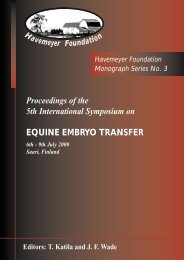Proceedings of a Workshop on - The Havemeyer Foundation
Proceedings of a Workshop on - The Havemeyer Foundation
Proceedings of a Workshop on - The Havemeyer Foundation
Create successful ePaper yourself
Turn your PDF publications into a flip-book with our unique Google optimized e-Paper software.
<strong>Havemeyer</strong> Foundati<strong>on</strong> M<strong>on</strong>ograph Series No. 11<br />
DECISION MAKING IN PRACTICE FOR TREATMENT<br />
OF RECURRENT LARYNGEAL NEUROPATHY<br />
T. R. C. Greet<br />
Rossdale & Partners, Beaufort Cottage Equine Hospital, Cott<strong>on</strong> End Road, Exning, Newmarket, Suffolk<br />
CB8 7NN, UK<br />
Recurrent laryngeal neuropathy is <strong>on</strong>e <str<strong>on</strong>g>of</str<strong>on</strong>g> the<br />
comm<strong>on</strong>est respiratory c<strong>on</strong>diti<strong>on</strong>s encountered in<br />
equine practice. Nowadays endoscopy is available<br />
and used routinely in the vast majority <str<strong>on</strong>g>of</str<strong>on</strong>g><br />
practices, and c<strong>on</strong>firmati<strong>on</strong> <str<strong>on</strong>g>of</str<strong>on</strong>g> the diagnosis in at<br />
least the more advanced case is relatively<br />
straightforward. It is the interpretati<strong>on</strong> in the less<br />
severely affected horse that represents a far greater<br />
challenge to the less experienced clinician and <strong>on</strong>e<br />
that can lead to difficulty when treatment opti<strong>on</strong>s<br />
are to be c<strong>on</strong>sidered.<br />
<strong>The</strong> author has used a 10 grade assessment <str<strong>on</strong>g>of</str<strong>on</strong>g><br />
the disease based up<strong>on</strong> the endoscopic appearance<br />
<str<strong>on</strong>g>of</str<strong>on</strong>g> laryngeal functi<strong>on</strong> and at least 3 other systems<br />
will be discussed at this meeting. <strong>The</strong> key factor in<br />
deciding what, if any, surgical therapy is appropriate<br />
for an individual horse, is the degree <str<strong>on</strong>g>of</str<strong>on</strong>g> its disability,<br />
which can be extremely difficult to assess.<br />
Having briefly and unsuccessfully used<br />
neuromuscular pedicle grafting, the author’s<br />
surgical treatments are based up<strong>on</strong> more<br />
traditi<strong>on</strong>al approaches. In the UK, surgical<br />
ablati<strong>on</strong> <str<strong>on</strong>g>of</str<strong>on</strong>g> the vocal cord and ventricle are still<br />
accepted as valid procedures in the ‘noisy’ horse<br />
with satisfactory performance. In the author’s<br />
hospital this is performed this using a diode or<br />
Nd:YAG laser in the standing patient. This has<br />
proved an attractive opti<strong>on</strong> for clients, although no<br />
more effective than using the traditi<strong>on</strong>al approach.<br />
<strong>The</strong> author believes that it is <str<strong>on</strong>g>of</str<strong>on</strong>g> benefit when<br />
combined with laryngoplasty in reducing the<br />
incidence <str<strong>on</strong>g>of</str<strong>on</strong>g> wound problems significantly.<br />
Laryngoplasty is reserved for horses which are<br />
‘short <str<strong>on</strong>g>of</str<strong>on</strong>g> air’ and performance is clearly<br />
suboptimal. <strong>The</strong> author uses 2 implants (a braided<br />
elastic and a coated braided polyester suture) as<br />
this technique seems to produce the most reliable<br />
results. Owners are counselled carefully regarding<br />
post operative management in particular. Time<br />
spent at this stage in communicati<strong>on</strong> is well<br />
worthwhile in reducing misunderstandings and<br />
client dissatisfacti<strong>on</strong> in the post operative period.<br />
<strong>The</strong> prognosis for the combined operati<strong>on</strong> is hard<br />
to assess. In a survey undertaken by the author<br />
involving over 100 horses, a detailed resp<strong>on</strong>se<br />
was obtained in 66 cases. Of these 49 (ie<br />
nearly 75%) were deemed to be performing with<br />
a major improvement after surgery (ie with little<br />
or no evidence <str<strong>on</strong>g>of</str<strong>on</strong>g> laryngeal obstructi<strong>on</strong>).<br />
Ten additi<strong>on</strong>al cases had significant<br />
performance improvement despite evidence<br />
<str<strong>on</strong>g>of</str<strong>on</strong>g> persistent laryngeal obstructi<strong>on</strong>. Chr<strong>on</strong>ic<br />
sepsis necessitated the removal <str<strong>on</strong>g>of</str<strong>on</strong>g> implants in 3<br />
horses but <strong>on</strong>ly <strong>on</strong>e was removed because <str<strong>on</strong>g>of</str<strong>on</strong>g><br />
dysphagia.<br />
<strong>The</strong> implicati<strong>on</strong>s <str<strong>on</strong>g>of</str<strong>on</strong>g> the survey were that<br />
careful patient selecti<strong>on</strong> is vital. Three <str<strong>on</strong>g>of</str<strong>on</strong>g> the<br />
unimproved group had underg<strong>on</strong>e previous<br />
laryngeal surgery, which might be c<strong>on</strong>sidered a<br />
bad prognostic sign. Clearly good results are<br />
easier to achieve in horses which have lower<br />
respiratory demands at exercise and in patients<br />
with a proven athletic record, as these animals<br />
tend to resp<strong>on</strong>d better to surgical procedures.<br />
59








